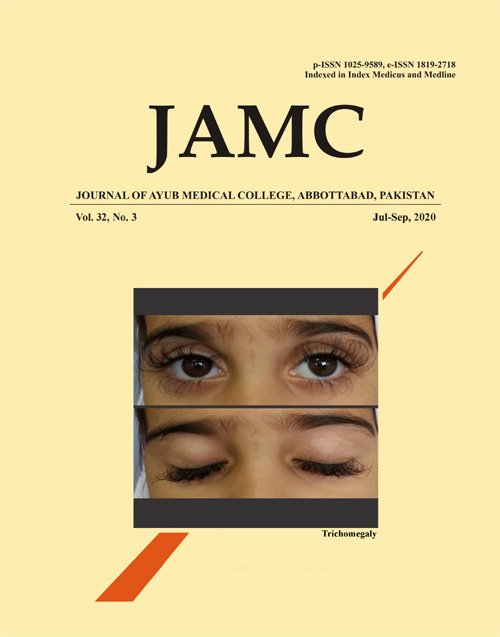VALIDITY OF GRAYSCALE ULTRASOUND AND RESISTIVE INDEX IN THE DETECTION OF NATURE OF OVARIAN NEOPLASMS BY TAKING HISTOPATHOLOGY AS A GOLD STANDARD
Abstract
Background: The utility of ultrasound has long been established in the diagnosis of benign and malignant ovarian neoplasms. Ultrasound is a safe and non-invasive imaging modality that has a high sensitivity and specificity. The objective was to determine the validity of grayscale ultrasound and resistive index in the detection of nature of ovarian neoplasms by taking histopathology as a gold standard. Methods: It was Cross-sectional study conducted in department of Radiology, Ayub Teaching Hospital Abbottabad from May 16 to November 30, 2014. Two-hundred-twenty-one female patients in whom an adnexal mass was noted on pelvic ultrasound were included in the study. Results: Out of these 221 patients, malignant ovarian masses were present in 50 (22.62%) patients on grayscale ultrasound. While a resistive index ≤0.6 was found in 56 (25.34%) patients. Over all the sensitivity of grayscale ultrasound was 95% and the specificity was 93.37%. Likewise, the sensitivity and specificity of resistive index were 95% and 90.06% respectively. Conclusion: This study showed the grayscale ultrasound is a sensitive imaging modality for differentiation of benign and malignant ovarian masses.Keywords: Adnexal masses; Ultrasound; Doppler; Resistive Index; Carcinoma; OvaryReferences
Pérez-López FR, Chedraui P, Troyano-Luque JM. Peri- and postmenopausal incidental adnexal masses and the risk of sporadic ovarian malignancy: new insights and clinical management. Gynecol Endocrinol 2010;26(9):631–43.
Forstner R, Sala E, Kinkel K, Spencer JA. European Society of Urogenital Radiology. ESUR guidelines: ovarian cancer staging and follow-up. Eur Radiol 2010;20(12):2773–80.
Majeed H, Ramzan A, Imran F, Rehman M. Validity of resistive index for the diagnosis of malignant ovarian masses. J Pak Med Assoc 2011;61(11):1104–7.
Perren TJ, Swart AM, Pfisterer J, Ledermann JA, Pujade-Lauraine E, Kristensen G, et al. A phase 3 trial of bevacizumab in ovarian cancer. N Engl J Med 2011;365(26):2484–96.
Bast RC, Skates S, Lokshin A, Moore RG. Differential diagnosis of a pelvic mass: improved algorithms and novel biomarkers. Int J Gynecol Cancer 2012;22(Suppl 1):S5–8.
Aziz Z, Sana S, Saeed S, Akram M. Institution based tumor registry from Punjab: five year data based analysis. J Pak Med Assoc 2003;53(8):350–3.
Gupta N. Adnexal Masses in Perimenopausal Women: How Effective is Color Flow Mapping and Pulse Doppler Waveform Studies in detecting Malignancy Preoperatively? J South Asian Feder Menopause Soc 2013;1(1):27–33.
Shah D, Shah S, Parikh J, Bhatt C, Vaishnav K, Bala D. Doppler Ultrasound: A Good and Reliable Predictor of Ovarian Malignancy. J Obstet Gynaecol India 2013;63(3):186–9.
Fleischer AC, Lyshchik A, Fishman DA. Contrast-Enhanced Trans vaginal Sono graphy of Ovarian Masses: Potential Role in Early Diagnosis of Ovarian Cancer. In: Saba L, Acharya UR, Guerriero S, Suri JS, editors. Ovarian Neoplasm Imaging. Boston, MA: Springer US, 2013; p. 465–78.
Testa AC, Timmerman D, Van Holsbeke C, Zannoni GF, Fransis S, Moerman P, et al. Ovarian cancer arising in endo metrioid cysts: ultrasound findings. Ultrasound Obstet Gynecol 2011;38(1):99–106.
Brown DL, Doubilet PM, Miller FH, Frates MC, Laing FC, DiSalvo DN, et al. Benign and malignant ovarian masses: selection of the most discriminating gray-scale and Doppler sono graphic features. Radiology 1998;208(1):103–10.
Fleischer A, James A, Millis J, Julian C. Differential diagnosis of pelvic masses by gray scale sono graphy. Am J Roentgenol 1978;131(3):469–76.
Valentin L. Pattern recognition of pelvic masses by gray-scale ultrasound imaging: the contribution of Doppler ultrasound. Ultrasousnd Obstet Gynecol 1999;14(5):338–47.
Timmerman D, Testa AC, Bourne T, Ameye L, Jurkovic D, Van Hols beke C, et al. Simple ultrasound-based rules for the diagnosis of ovarian cancer. Ultrasound Obstet Gynecol 2008;31(6):681–90.
Smorgick N, Maymon R. Assessment of adnexal masses using ultrasound: a practical review. Int J Womens Health 2014;857–63.
Published
Issue
Section
License
Journal of Ayub Medical College, Abbottabad is an OPEN ACCESS JOURNAL which means that all content is FREELY available without charge to all users whether registered with the journal or not. The work published by J Ayub Med Coll Abbottabad is licensed and distributed under the creative commons License CC BY ND Attribution-NoDerivs. Material printed in this journal is OPEN to access, and are FREE for use in academic and research work with proper citation. J Ayub Med Coll Abbottabad accepts only original material for publication with the understanding that except for abstracts, no part of the data has been published or will be submitted for publication elsewhere before appearing in J Ayub Med Coll Abbottabad. The Editorial Board of J Ayub Med Coll Abbottabad makes every effort to ensure the accuracy and authenticity of material printed in J Ayub Med Coll Abbottabad. However, conclusions and statements expressed are views of the authors and do not reflect the opinion/policy of J Ayub Med Coll Abbottabad or the Editorial Board.
USERS are allowed to read, download, copy, distribute, print, search, or link to the full texts of the articles, or use them for any other lawful purpose, without asking prior permission from the publisher or the author. This is in accordance with the BOAI definition of open access.
AUTHORS retain the rights of free downloading/unlimited e-print of full text and sharing/disseminating the article without any restriction, by any means including twitter, scholarly collaboration networks such as ResearchGate, Academia.eu, and social media sites such as Twitter, LinkedIn, Google Scholar and any other professional or academic networking site.









